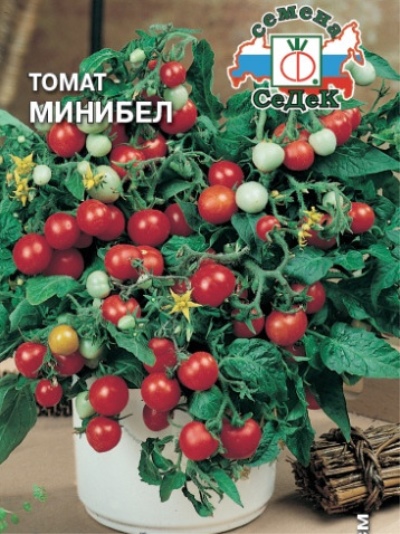
- Authors: Lukyanenko A. N., Dubinin S. V., Dubinina I. N. (Agrofirm Sedek LLC)
- Year of approval: 2015
- Category: grade
- Growth type: determinant
- Appointment: fresh consumption, for pickling and preserving
- Ripening period: early
- Ripening time, days: 89-96
- Growing conditions: for open ground, for film greenhouses, for balconies, for growing on a windowsill, decorative landscaping
- Bush size: undersized
- Bush height, cm: 30-40
Minibel tomatoes are a great option for those who like planting miniature plants in indoor conditions. In addition to fresh appetizing fruits, the bush itself with a scattering of small cherry tomatoes can be an excellent home decor.
Description of the variety
The bushes of the plant can reach 40 cm, although some gardeners note the predominance of low bushes from 15 cm. Fruits ripen within 3 months from the moment of planting.
Advantages of the Minibel variety:
pleasant taste;
the minimum period of fruit ripening;
beautiful appearance of tomatoes and bushes;
ease of processing and unpretentiousness of plants;
small size of the culture.
Gardeners practically do not notice any drawbacks in this tomato variety.
The main qualities of the fruit
The fruits are lightweight, from 15 to 24 g, round in shape, smooth to the touch. Perfect for canning, fresh consumption, use for preparing second courses and snacks, as well as decorating a festive table.
Taste characteristics
Tomatoes taste sweet, fleshy.
Ripening and fruiting
Minibel can be attributed to the early ripening varieties. Tomatoes are ripe within three months of planting.
Yield
With the complex required care, you can collect an impressive amount of tomatoes from each bush. This will require regular fertilization, competent bush formation and timely watering. An important point is the removal of stepchild branches to increase yields. In some cases, even untreated bushes give a rich harvest.
The timing of planting seedlings and planting in the ground
Tomatoes need to be transplanted into the ground or, if we are talking about growing at home, in a pot for indoor plants, no older than 40-50 days from the moment of planting.
To multiply the culture, they resort to sowing seeds, the timing of which is flexible. If you need to get fresh tomatoes for the New Year holidays, you need to plant in August. If vegetables are required by the spring, planting should be done at the beginning of winter. Planting tomatoes in the spring will provide gardeners with fresh vegetables in the summer.
Indoor cultivation of a crop requires additional artificial lighting. Despite the fact that the plants of the variety in question are not highly demanding on lighting, the lack of light will lead to a decrease in the rate of development of tomatoes.

Growing tomato seedlings is an extremely important process, because it largely depends on whether the gardener can harvest at all. All aspects must be taken into account, from seedbed preparation to planting in the ground.
Landing scheme
Before planting, pre-treatment of seeds in a solution of potassium permanganate for a quarter of an hour is required. To speed up the growth rate of the plant, you should wrap the seeds in toilet paper dampened with water.The soaked seeds should be placed in a saucer, then covered with a plastic bag and removed to a warm place.
If the air temperature in the room exceeds + 25 ° C, the seeds will sprout quickly, after which they will need to be planted in prepared containers with soil. When a second sheet appears, it can be planted in individual disposable cups.
Indoor growing of tomatoes involves specially prepared soil from 4 parts of black soil, 5 parts of humus and 1 part of sand.

Growing and care
Seedlings planted in the ground require timely feeding and regular watering. It should be carried out in large quantities, but with long breaks. You can feed and water at the same time. It is undesirable to apply fertilizer to dry soil in order to avoid damage to the roots. Both standard mineral and specialized for tomatoes are suitable for feeding.
During the entire growing season, plant feeding should be performed at least three times. The first stage - within two weeks from the moment of disembarkation in the general container, the second - after the appearance of flower brushes, the third - from the moment of the formation of the ovary.




A plant needs different micronutrients at each stage of growth. All fertilizers can be divided into two groups: mineral and organic. Folk remedies are often used: iodine, yeast, bird droppings, eggshells.
It is important to observe the rate and period of feeding. This also applies to folk remedies and organic fertilizers.


Review overview
In general, the reviews about this variety of tomatoes are positive.Many non-professional gardeners note the unpretentiousness of the culture, high yield and excellent taste of tomatoes.
Many are pleased with the versatility of tomatoes, because they are perfect both for eating unprocessed and for canning.
Minibel tomatoes are a great option for lovers of fresh vegetables.

























































































